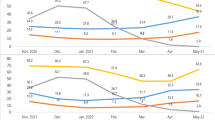Abstract
The mycoflora of culm bases and roots of rye was assessed in field trials, where benomyl was applied at dose rates ranging from 0.24 to 4.80 kg ha−1. Samples of culm bases were taken three times during the growing season, those of roots only at the harvest date. On culms with various symptoms from untreated plots,Pseudocercosporella herpotrichoides, Alternaria spp. andGerlachia nivalis were prevalent and on those from benomyl-treated plotsAlternaria spp. andFusarium culmorum. In later stages of growth,G. nivalis sharply declined andAlternaria spp. andF. culmorum increased. At the end of the season,Periconia macrospinosa andTyphula incarnata appeared in treated plots.
In samples of roots taken more than two months after the last spray, porosporous dematiaceous species (Alternaria, Ulocladium andDendryphion), Mortierella spp. and other resistant fungi were prevalent in plots treated with 1.20 kg ha−1 or more, but not in those that received 0.24 kg ha−1, which is recommended for disease control. Lower counts were recorded only for species that are highly sensitive in vitro, e.g.Microdochium bolleyi andTrichoderma spp. Some fusaria were either not affected or tended to be slightly stimulated by the treatment. An attempt was made to attribute the incidence of these moderately sensitive fungi to the effect of the fungicide on non-pathogens.
Samenvatting
De schimmelflora van de halmvoet en de wortels werd bepaald in veldproeven, waar benomyl was toegepast in doseringen variërend van 0,24 tot 4,80 kg ha−1. De monsters van de halmvoeten werden drie maal gedurende het groeiseizoen genomen, die van de wortels alleen op het tijdstip van de oogst. Op halmen met diverse symptomen uit onbehandelde proefveldjes kwamenPseudocercosporella herpotrichoides, Gerlachia nivalis enAlternaria-soorten het meest voor, op die uit behandelde domineerdenAlternaria-soorten enFusarium culmorum. Tijdens het afrijpen liepG. nivalis sterk terug en namenAlternaria enF. culmorum toe. Aan het eind van het groeiseizoen verschenenPericonia macrospinosa enTyphula incarnata in behandelde veldjes.
De wortelmonsters werden ruim twee maanden na de laatste bespuiting genomen. Resistente schimmels, zoals de porospore Dematiaceae (Alternari, Ulocladium enDendryphion) enMortierella-soorten waren toegenomen in proefveldjes die met 1,20 kg ha−1 of meer waren behandeld. Dat was niet het geval in de veldjes behandeld met de geadviseerde praktijkdosering van 0,24 kg ha−1. Een vermindering van de populatie werd alleen voor zeer gevoelige soorten alsMicrodochium bolleyi enTrichoderma-soorten waargenomen. DeFusarium-soorten, hoofdzakelijkF. culmorum enF. avenaceum, werden niet beïnvloed of bleken te tenderen naar een lichte toename tengevolge van de behandeling. In de discussie is getracht om het zich handhaven van deze betrekkelijk gevoelige schimmels in verband te brengen met een effect van het fungicide op de niet-pathogene schimmelflora.
Similar content being viewed by others
References
Bertoldi, M. de, Rambelli, A., Giovannetti, M. & Griselli, M., 1978. Effects of benomyl and captan on rhizosphere fungi and the growth ofAllium cepa. Soil Biol. Biochem. 10: 265–268.
Bollen, G.J., 1971. Resistance to benomyl and some chemically related compounds in strains ofPenicillium species. Neth. J. Pl. Path. 77: 187–193.
Bollen, G.J., 1982. Fungicide resistance and microbial balance. In: Dekker, J., & Georgopoulos, S.G. (Eds.), Fungicide resistance in crop protection. Pudoc, Wageningen, p. 161–176.
Bollen, G. J. & Fuchs, A., 1970. On the specificity of the in vitro and in vivo antifungal activity of benomyl. Neth. J. Pl. Path. 76: 299–312.
Duben, J. & Fehrmann, H., 1979. Vorkommen und Pathogenität vonFusarium-Arten an Winterweizen in der Bundesrepublik Deutschland. 1. Artenspektrum und jahreszeitliche Sukzession an der Halmbasis. Z. PflKrankh. PflSchutz 86: 638–652.
Emden, J.H. van, 1972. Soil mycoflora in relation to some crop plants. Eppo Bull. 7: 17–26.
Fehrmann, H. & Schrödter, H., 1972. Ökologische Untersuchungen zur Epidemiologie vonCercosporella herpotrichoides. IV Erarbeitung eines Praxisnahen Verfahrens zur Bekämpfung der Halmbruchkrankheit des Weizens mit systemischen Fungiziden. Phytopath. Z. 74: 161–174.
Fokkema, N.J., Laar, J.A.J. van der, Nelis-Blomberg, A.L. & Schippers, B., 1975. The buffering capacity of the natural mycoflora of rye leaves to infection byCochliobolus sativus, and its susceptibility to benomyl. Neth. J. Pl. Path. 81: 176–186.
Hanuss, K. & Oesau, A., 1977. Einfluss von Fungiziden auf Erreger parasitärer Halmbasiserkrankungen und auf den Ertrag. Mitt. biol. BundAnst. Ld-und Forstw. 178: 118–119.
Hoes, J.A., 1962. Dynamics of the mycoflora of subterranean parts of winter wheat in the dryland area of Washington. Phytopathology 52: 736 (Abstr.).
Hoeven, E.P. van der & Bollen, G.J., 1980. Effect of benomyl on soil fungi associated with rye. 1. Effect on the incidence of sharp eyespot caused byRhizoctonia cerealis. Neth. J. Pl. 86: 163–180.
Hossfeld, R., 1974. Förderung derTyphula-Fäule an Wintergerste durch Einsatz von Fungiziden zur Halmbruchbekämpfung. NachrBl. dt. PflSchutzdienst 26: 19.
Kuramoto, T., 1976. Resistance to benomyl and thiophanate-methyl in strains ofPenicillium digitatum andP. italicum in Japan. Pl. Dis. Reptr 60: 168–172.
Malone, J.P., McGimpsey, H.C. & McIlwaine, R.S., 1978. Effect of some fungicides on the yield of grass swards. Ann. Appl. Biol. 90: 65–71.
Platenkamp, R.G.H. & Bollen, G.J., 1973. The effect of benomyl sprays on the root mycoflora of rye. Acta bot.neerl. 22: 168–169 (Abstr.).
Reinecke, P., 1977. Untersuchungen zum Erregerspektrum des Fusskrankheitskomplexes an Getreide unter besonderer Berücksichtigung vonRhizoctonia solani Kühn. Thesis Universität Göttingen, 141 pp.
Reinecke, P., 1978.Microdochium bolleyi at the stem base of cereals. Z. PflKrankh. PflSchutz 85: 679–685.
Scott, D.B., Visser, C.P.N. & Rufenacht, E.M.C., 1979. Crater disease of summer wheat in African drylands. Pl. Dis. Reptr. 63: 836–840.
Tuyl, J.M. van, 1977. Genetics of fungal resistance to systemic fungicides. Meded. Landb.-Hogeschool. Wageningen: 77–2, 136 pp.
Uoti, J., 1979. Study of control of seed-borneFusarium in cereals. Ann. Agric. Fenn. 18: 149–153.
Weber-Czerwińska, E., 1977. Grzyby wystepujace na korzeniack pszenicy odmiany Grana traktowanej fungicydem benomyl. Acta Univ. Nicolai Copernici, Nauki Mat.-Przyr. 42, Biol. 20: 41–48.
Weber-Czerwińska, E., 1979. Dalsze badania nad oddzialywaniem benomylu na mikroflore korzeniowa pszenicy ozimej odmiany Grana. Zesz. probl. Postep. Nauk roln. 230: 157–164.
Author information
Authors and Affiliations
Rights and permissions
About this article
Cite this article
Bollen, G.J., Van Der Hoeven, E.P., Lamers, J.G. et al. Effect of benomyl on soil fungi associated with rye. 2. Effect on fungi of culm bases and roots. Netherlands Journal of Plant Pathology 89, 55–66 (1983). https://doi.org/10.1007/BF01974444
Accepted:
Issue Date:
DOI: https://doi.org/10.1007/BF01974444




